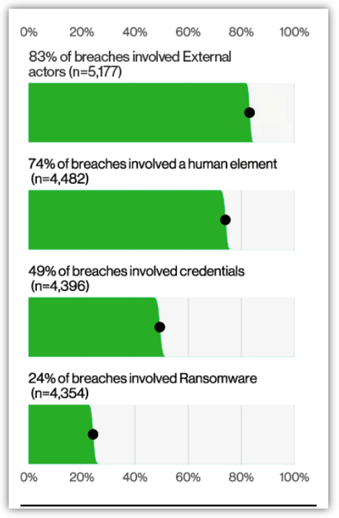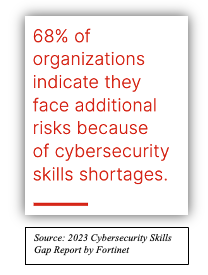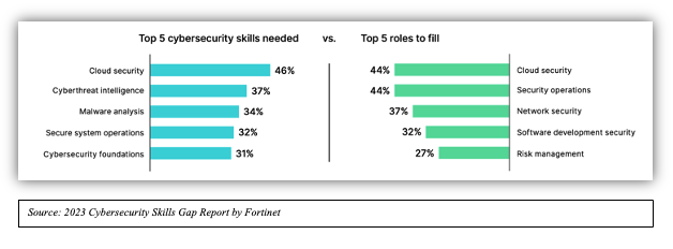Smart Cyber Budgeting for 2024
In today's fast-paced digital world, where cyber threats evolve as quickly as the technologies they target, small and medium-sized businesses (SMBs) find themselves at a crucial crossroads. 2024 presents a unique blend of challenges and opportunities in cybersecurity, demanding not just attention but action. What SMBs must focus on to fortify their defenses against the sophisticated cyber threats ? It's time to turn awareness into action and ensure your business is not just surviving but thriving in the digital age.
Reevaluating Phishing and Security Awareness Training
Reevaluating phishing and security awareness training is crucial for the Company. Despite significant investments in such training, phishing continues to pose a considerable threat. A report from Proofpoint's State of the Phish highlights that nearly half of organizations deal with at least one successful phishing attack. This situation underscores the need for the Companies to not only continue but also enhance their efforts in educating employees about these risks.
Hence, the Companies should consider redirecting part of their cybersecurity budget towards advanced training methodologies and technologies. This includes integrating simulations of real-life phishing scenarios, which can better prepare employees to recognize and respond to sophisticated phishing attempts. Additionally, training should be regularly updated to reflect the latest tactics used by cybercriminals, ensuring that employees are aware of current threats.
Another aspect is the consideration of new technologies, such as remote browser isolation (RBI), to mitigate the risk of phishing. RBI technology can isolate malicious content from the user’s environment, providing a more secure browsing experience. This approach can substantially reduce the vulnerability of organizations to phishing attacks.
Remote Work Security
As remote work becomes increasingly prevalent, the Companies must adapt their cybersecurity strategies to protect against the unique challenges this trend presents. By 2025, a substantial portion of the workforce is expected to work remotely at least part of the time, heightening the importance of securing remote endpoints. The expansion of the remote workforce has led to an increase in unprotected endpoint devices, making them prime targets for cyber attackers. To address these vulnerabilities, the Companies need to focus on enhancing remote work security as a key part of their cybersecurity budget for 2024.

A critical step in this strategy is ensuring that all endpoint devices, such as personal laptops, mobile phones, and tablets, are equipped with up-to-date antivirus software, firewalls, and intrusion detection systems. These tools can significantly reduce the risk of malware infections and other cyber threats. Additionally, the Companies should monitor how employees access various systems, especially when logging in remotely. Unusual login activities, such as logging in from unexpected locations or at odd hours, could indicate a potential internal or insider threat.
Misconfiguration and Unpatched Vulnerabilities
In allocating cybersecurity budget for 2024, the Companies must prioritize addressing misconfiguration and unpatched vulnerabilities, which have been identified as key areas of concern. The Verizon 2022 and 2023 Data Breach Investigations Reports highlight misconfigurations as the second most common cause of data breaches, underestimating their significant impact on cybersecurity. To combat this concern it requires a robustly manage and monitor their digital assets, implementing a systematic approach that includes regular patch management, thorough security audits, and the employment of automated tools to identify and rectify misconfigurations promptly.

This focus is not just about fixing existing vulnerabilities; it's about establishing a proactive, ongoing process to prevent new ones from arising. Regular patch management is a critical component of this strategy. It ensures that all software and systems are up-to-date, closing off known vulnerabilities that could be exploited by cyber attackers. Furthermore, security audits provide a comprehensive examination of an organization's existing security posture, identifying potential weaknesses and areas for improvement.
AI and Ransomware Threats
In 2024, the threat landscape is increasingly complicated by advancements in AI and the evolution of ransomware tactics. AI technology is being leveraged by cybercriminals to create more sophisticated malware and phishing attempts. These can include highly convincing deepfake videos and graphics that mimic legitimate sources, making it challenging to detect and prevent cyberattacks. The businesses need to allocate a significant portion of their cybersecurity budget to combat these evolving threats.
The strategy should include investing in tools and processes to effectively protect from AI-enhanced cyber threats. Such processes and tools can proactively identify and mitigate sophisticated attacks before they cause harm. Additionally, a focus on employee education is paramount. Training programs should cover how to recognize the signs of an AI-generated attack, equipping employees with the knowledge and tools to respond effectively.
Regarding ransomware, the Companies must be aware of the shift toward more aggressive tactics, such as double extortion ransomware. In these attacks, cybercriminals not only demand a ransom to decrypt data but also threaten to sell or publish the stolen data. To mitigate this, every data driven business should invest in robust data backup and recovery plans, ensuring they have immutable copies of critical data.
In essence, the cybersecurity budget for 2024 should reflect an integrated approach that combines AI-driven security solutions, comprehensive training, and solid data backup strategies. This approach can provide the businesses with a robust defense against the dual threats of AI-enhanced cyberattacks and ransomware evolution.
Cybersecurity Skills Shortage
Addressing the cybersecurity skills shortage is vital for the businesses in 2024. This gap is particularly challenging for SMBs with limited resources, hindering their defense against complex cyber threats. The 2023 Cybersecurity Skills Gap Report by Fortinet underscores this issue, revealing that 68% of organizations experience heightened risks due to this shortage. Security roles, notably in cloud security and security operations, are among the most difficult to staff. This data emphasizes the importance of strategic initiatives to overcome the skills gap in cybersecurity.
 In response to this challenge, SMBs should allocate a portion of their cybersecurity budget to partner with external resources or managed service providers (MSPs). Working with MSPs can provide SMBs with access to the necessary skills and expertise that they may lack internally. This approach not only helps in bridging the skills gap but also ensures that SMBs remain secure against evolving cyber threats. MSPs typically offer customizable, cost-effective solutions, allowing SMBs to pay only for the services they need.
In response to this challenge, SMBs should allocate a portion of their cybersecurity budget to partner with external resources or managed service providers (MSPs). Working with MSPs can provide SMBs with access to the necessary skills and expertise that they may lack internally. This approach not only helps in bridging the skills gap but also ensures that SMBs remain secure against evolving cyber threats. MSPs typically offer customizable, cost-effective solutions, allowing SMBs to pay only for the services they need.
Additionally, investing in training and development programs for existing staff can be a strategic move. Such programs can enhance the cybersecurity knowledge and skills of current internal specialists, making them more adept at handling security issues.

By focusing on these strategies, SMBs can effectively navigate the challenges posed by the cybersecurity skills shortage, enhancing their overall security posture in an increasingly complex digital landscape even with limited financial resources.
Summary
In summary, to ensure your SMB thrives in the dynamic 2024 cybersecurity landscape, it's time to take decisive action. Begin by rigorously addressing misconfigurations and unpatched vulnerabilities in your systems – this isn't just a recommendation, it's a necessity for safeguarding your digital assets. Embrace the shift to remote work by fortifying endpoint security; this is an investment in your business's resilience. Elevate your phishing and security awareness training; staying ahead of cybercriminals requires continuous learning and adaptation.
Moreover, confront the emerging AI and ransomware threats head-on by allocating resources towards advanced, AI-integrated cybersecurity measures. Lastly, don't let the cybersecurity skills shortage be a disaster for the business. Team up with MSPs to fill the gaps and consider upskilling your current team. These steps aren't just strategies; they're essential moves to protect, empower, and future-proof your business against evolving cyber threats. Act now to secure your business's digital future.